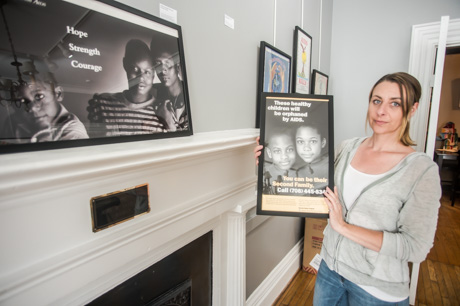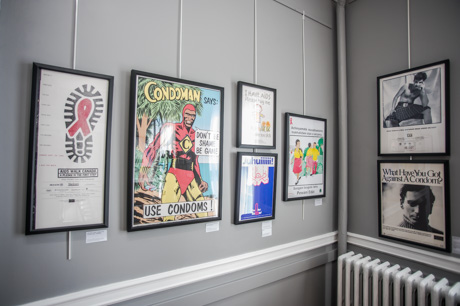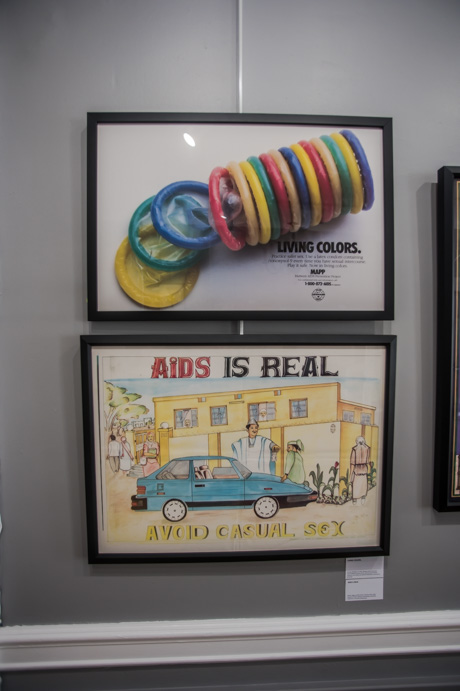Batavia native's AIDS poster exhibit visits his hometown


An exhibit culled from more than 8,000 posters collected from Batavia native Dr. Edward Atwater is coming to Batavia, Mary Jo Whitman says.
An education director for GO ART!, Whitman has been busy setting up the exhibit at GO ART!, 201 East Main St. Known personally and professionally as a history buff with an affinity for collecting relics of the time, Atwater spied his first poster on a subway, and he never looked back.
The late physician made it his mission to obtain posters about AIDS awareness — from all corners of the globe. Memorial Art Gallery in Rochester is currently hosting the first major exhibition that’s devoted to the University of Rochester’s vast HIV/AIDS-related posters.
“For those of us that didn’t experience the shame, the guilt, or the fear, it’s hard to really put magnitude of the AIDS epidemic into perspective, especially in the early days. I think this exhibit really helps in that capacity. Some of these posters are very eye opening and heart wrenching,” Whitman said to The Batavian. “Some bring to the forefront how awareness advocacy groups tried to dispel the misinformation on contraction and how the impact was beyond the scope of a few marginalized groups. Certainly, I encourage everyone to go to the Memorial Art Gallery to see the larger exhibit, it is worth the trip to Rochester, but I also think even at a much smaller scale, the portion of the exhibit that we have at GO ART! is a must-see.”
An opening reception for Up Against the Wall: Art, Activism and the AIDS Poster has been set for 6 to 8:30 p.m. June 10. GO Art! will have 28 of those posters on display in the Gallery in Seymour Dining Room.
Described as “visually arresting,” the exhibit — even on a smaller scale in Batavia — tell a story of how the very topic of AIDS evolved along with knowledge, awareness and treatments. From the crude but necessary — pictures illustrating how to put on a condom — to the poignant messages that life is to be protected by both men and women, this exhibit covers it all. There are black and white images with somber messages, a superhero named Condoman and vividly colorful graphics, all trying to convey the importance of protection in the face of a deadly disease. These displays aren't without a grain of humor, as one picture shows a man with an umbrella and the words "Don't forget your rubbers."
In those early days in the 1980s, there wasn’t much talk or action to prevent what grew into an epidemic of illness, death, and shame.
“From the beginning of the AIDS epidemic, groups already stigmatized by the community were impacted the most, including gay men and intravenous drug users,” Whitman said. “As if losing members of their community at an alarming rate, and living in fear of catching a deadly disease that the medical community knew little about, was not bad enough, the epidemic was used as a platform to paint people infected with HIV as the dangerous ‘other’ who posed a threat to public safety.
“The prominent rhetoric pushed the idea that the infected were degenerates, that they were dirty, and disease ridden, ultimately bringing HIV/AIDS upon themselves with their undesirable lifestyles,” she said. “This mentality and unfair treatment of infected groups not only had detrimental psychological impacts, the stigma manifested in discrimination throughout many different aspects of society, including health care, education, employment, families, and communities. The shame placed on these individuals, in many regards, enabled the spread of the virus as many were afraid to get tested, take proper precautions, and have open conversations with their partners out of fear of being harassed or even assaulted.”
Atwater’s insights led him on a trail of obtaining posters from various governments and health departments as hard evidence of how this topic was being portrayed in print. Posters were hung up in bathrooms, subways and other public spaces, and he worked diligently to secure copies of them all. His collection ballooned to more than 8,000 posters from more than 130 countries and in several languages.
A medical historian who was devoted to his workplace, University of Rochester Medical Center, Atwater donated his collection, among others, to the university’s River Campus Libraries’ Department of Rare Books, Special Collections and Preservation. Not only do the posters illustrate the differing colors, graphics and words used throughout the world, but they also demonstrated “the wide range of communication strategies used to educate and inform people about this devastating global epidemic,” Whitman said. All of that underscores “how beauty and creativity have grown out of the tragedy and destruction of this deadly virus,” she said.
“Dr. Atwater, a native of Batavia, would have been pleased to have a selection of the posters he collected shown in his hometown,” she said.
The Batavia exhibit will run through June 12. Hours are 11 a.m. to 4 p.m. Wednesdays, 11 a.m. to 9 p.m. Thursdays and Fridays, and 9 a.m. to noon Saturdays. Rochester’s exhibit will be available through June 19.
The Atwater Collection at the University of Rochester highlights how public health posters specific to HIV/AIDS represent “one of the most significant, prolific, and creative chapters in the more than 150-year history of poster art,” said collection curator and Up Against the Wall book editor Jessica Lacher-Feldman.
The AIDS Education Poster Collection (aep.library.rochester.edu) is housed in its entirety in the Department of Rare Books, Special Collections and Preservation at the U of R, and is the world’s largest single collections of visual resources related to the disease, Lacher-Feldman said. The entire collection has been digitized and is available and fully searchable online.
She encourages viewers to explore the posters and reflect on the scope and impact of HIV/AIDS in our communities and around the world. For more information about the GO ART! exhibit, call (585) 343-9313. For more information about the collection, contact Jessica Lacher-Feldman at JLF@rochester.edu.



Top Photo: Dr. Edward Atwater with some of his poster collection. Photo by J. Adam Fenster, University of Rochester. Mary Jo Whitman shows some of the collection at the GO Art! building, 201 East Main St., Batavia. Photos by Howard Owens.
